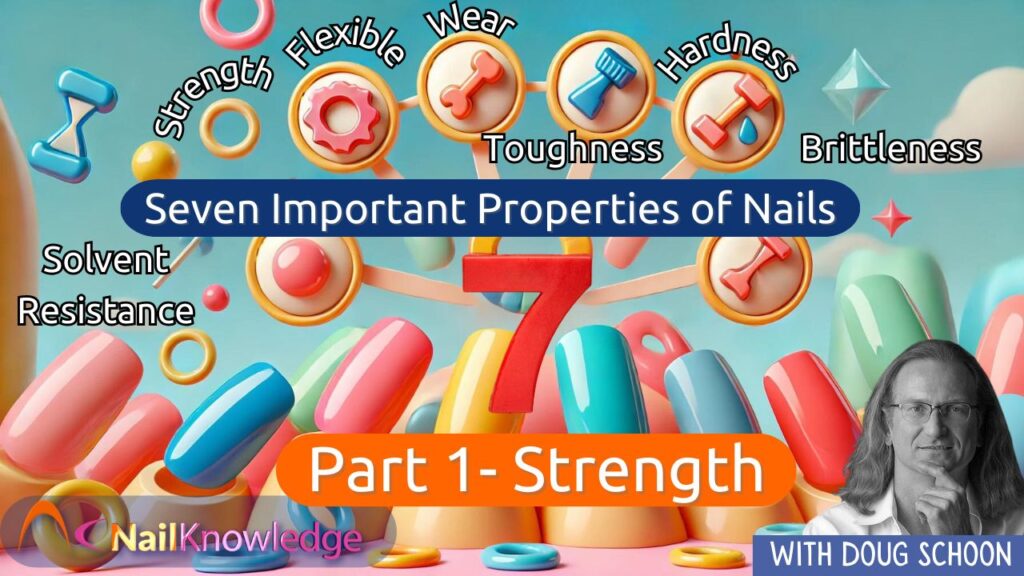Há sete propriedades importantes das unhas naturais e artificiais que geralmente são responsáveis pelo comportamento de suas unhas em situações reais.
Essas sete propriedades principais - resistência, dureza, flexibilidade, tenacidade, fragilidade, resistência a solventes e desgaste - são fundamentais para entender como as unhas naturais e artificiais funcionam e se comportam.
É interessante notar que essas mesmas propriedades se aplicam a revestimentos de unhas naturais e artificiais. Por exemplo, se um cliente prender sua unha natural ou artificial em alguma coisa, como essa unha reagirá? Ela rasgará ou rachará ou resistirá ao dano?
This often depends on one or more of these important properties. Let’s review them, so you can have a deeper understanding of how these properties can affect all types of nails.
A compreensão adequada dessas propriedades ajudará todos, desde os entusiastas das unhas até os profissionais, a fazer melhores escolhas para o cuidado e a manutenção das unhas.
Entendendo a resistência das unhas: A primeira propriedade fundamental das unhas naturais e artificiais
- Força – What is Strength?
We use the word all the time in many ways; everything from the strength of a person’s character to muscle strength training; but nails don’t have muscles.
Of course, they certainly can have lots of character as any fan of nail art knows and they can certainly be strong, in fact they can be too strong, even dangerously strong!
Strength is defined as the ability of a material to “resist breaking under the stress of a heavy load or impact”. Bridges are good examples. They must be strong enough to hold all the crossing cars. In this case, the cars are the heavy load.
Se deixar cair uma taça de vinho em um piso de cerâmica, ele não terá a força necessária para resistir ao impacto. Pelo mesmo motivo, um ladrilho de cerâmica dura se quebrará se uma frigideira pesada for derrubada. A força de um galho de árvore permite que ele resista à carga extra criada durante um vento forte. Nossos músculos devem ser fortes o suficiente para resistir à ruptura ao mover cargas pesadas. A força do cabelo permite que ele resista à quebra ao ser escovado.
Why Nail Plates Need Strength—But Not Too Much
Por que as placas ungueais precisam ser resistentes? Porque as usamos como ferramentas. Todo o trabalho de dobrar, pegar, erguer, cutucar, arranhar e arranhar que fazemos com nossas unhas é prova de sua resistência.
Strength isn’t the only property that nail plates must possess. There are several other important properties to consider. Would you want nails like titanium alloy? It is very strong, but we don’t want or need our nail plates to be that strong. Not so strong that the nail plate would rip away from the nail bed and matrix area if caught on something. It would be better if it broke instead, since the alternative would not be fun or pleasant and could cause serious, possibly irreversible damage to the nail bed and matrix. Also, if client’s nails were that hard and inflexible, they could poke out someone’s eye, maybe their own!
É claro que queremos unhas fortes, mas não tão fortes assim. Não é mesmo?
É importante que a placa ungueal se quebre sob certas condições, portanto, não deve ser muito forte. As placas ungueais são projetadas para quebrar em algum momento antes que ocorram danos mais sérios e potencialmente permanentes.
The Issue with MMA: Why It’s Too Strong for Artificial Nails
This is one of the problems of the use of methyl methacrylate monomer (MMA), which is sometimes used as an ingredient in certain monomer liquid and polymer powder (L&P) formulations. MMA is too strong. Rather than break when impacted, the force will cause the natural nail to crack, rather than the artificial nail coating.
Em outras palavras, o revestimento de unhas com MMA é muito forte para funcionar adequadamente como unha artificial. Há outros problemas com as propriedades do MMA que o tornam um ingrediente indesejável para unhas artificiais, que serão discutidos nesta postagem do blog MMA e o setor de unhas.
Explore mais propriedades importantes das unhas em nossa série de 7 partes:
- Força das unhas – Discover how the strength of nails impacts their performance and durability.
- Dureza das unhas – Understand the crucial role of hardness in nail health and how to maintain the perfect balance.
- Flexibilidade das unhas – Understand the importance of flexibility in preventing nail breakage and maintaining resilience.
- Resistência das unhas – Find out what makes nails tough and how this property differs from strength and hardness.
- Fragilidade das unhas – Learn what causes brittleness in nails and how to prevent it.
- Resistência a solventes para unhas – Explore how nails can resist damage from chemicals and solvents.
- Uso de unhas – Understand the factors that affect how well nails withstand regular use and environmental exposure.


